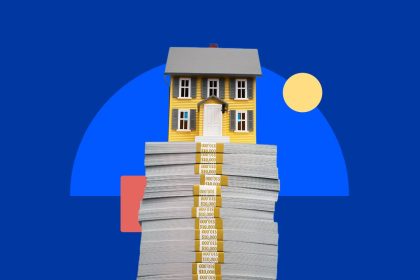MoMo Productions/Getty Images
Key takeaways
- If you’re nearing the end of your ARM loan’s initial fixed-rate period and your rate will rise significantly, you might be considering refinancing to a fixed-rate mortgage.
- A fixed-rate mortgage provides more predictability, as the interest rate and your monthly payment stay the same for the loan’s duration.
- You’ll need to meet ARM refinance requirements to apply, and it’s a good idea to compare offers from multiple lenders — not just your current lender.
If you’re nearing the end of the initial term on your adjustable-rate mortgage (ARM), you might be wondering if now is a good time to refinance to a fixed rate. Here, we break down how to refinance an ARM and when it’s a good idea to refinance to a fixed rate.
Can you refinance an ARM loan?
Yes, you can refinance an ARM loan. By doing so, you’ll replace your existing mortgage with a new one — it can be either another ARM or a fixed-rate mortgage.
A fixed-rate mortgage is a home loan with an interest rate that stays the same for the entire loan term, usually 15 or 30 years. This means your monthly principal and interest payments never change, which can make payments easier to plan for.
With an ARM, many people choose to refinance due to their rate adjusting higher. However, it’s important to remember that refinancing isn’t free — you’ll have to pay closing costs. So, even if you’re refinancing to a much lower rate, it’s smart to calculate your break-even point to determine when you’ll start saving money.
Keep in mind:
You don’t have to stick with your current lender when refinancing an ARM. Be sure to shop around to get the best rates and terms.
How to refinance an ARM
Refinancing an ARM is very similar to refinancing a fixed-rate mortgage. Here are the basic steps to follow:
- Compare quotes: Don’t just refinance with your current lender without shopping around first. Research multiple lenders and get quotes on rates, fees and terms that you can compare to find the best offer.
- Choose a lender and apply: Gather all of your financial documents and submit the paperwork and application to the lender of your choice.
- Schedule the appraisal: Like most mortgage loans, refinances generally require a home appraisal.
- Go through underwriting and close: The lender’s underwriting process will verify your finances. Once everything is in order, assuming your loan is approved, you’ll schedule a closing date to sign the paperwork and pay the closing costs.
Lenders typically offer specific mortgage refinancing loans, so you’ll use their refinance application form to apply. The fact that you already own the home can simplify the process.
Requirements for refinancing an adjustable-rate mortgage
Before you start the process, make sure you meet the requirements. The specific criteria may vary by lender, but here are some common requirements to refinance a mortgage, whether to another ARM or a fixed-rate loan:
- Credit score: Conventional loans generally require a credit score of at least 620.
- DTI ratio: To refinance, your debt-to-income ratio should be below 50 percent.
- Equity percentage: You typically need to maintain a minimum of 20 percent equity (though some lenders will allow less).
- Duration of ownership: In most cases, before a mortgage can be refinanced you’ll need to make at least six payments on the loan — meaning you need to have lived there for at least six months.
Costs of refinancing an ARM
Remember: Refinancing isn’t free. Before switching from an ARM to a fixed-rate loan, make sure you understand how much it costs to refinance a mortgage. You’ll need to budget for a number of expenses, including:
- Origination fee
- Appraisal fee
- Title services
On the plus side, refinancing costs often total far less than the closing costs on a home purchase loan. While many of the costs are fairly similar, you’ll skip a few when you refinance. For instance, you won’t be paying for a home inspection, and you likely won’t need to pay for an attorney. Similarly, unless you’re tapping equity, some fees will be lower since they’re calculated as a percentage of the loan amount.
Benefits of refinancing an ARM to a fixed-rate mortgage
Fixed-rate mortgages keep the same mortgage rate throughout the entire loan term. ARMs are more complex: An ARM is a 30-year loan with a fixed rate for an introductory period (typically three to 10 years). After this period, the rate adjusts every six months or once per year, based on a specific market index. While ARMs may offer an initial lower rate than a fixed-rate loan, once that introductory rate ends, your payment can go up significantly.
The idea of trading away the uncertainty of an adjustable-rate mortgage for the certainty of a fixed-rate mortgage is appealing, especially if you’re expecting an adjustment in the next year or two.
— Greg McBride, CFA, chief financial analyst for Bankrate
Here are the main benefits of refinancing an ARM to a fixed-rate mortgage:
- Your payments are always the same: A fixed-rate mortgage gives you the certainty of predictable payments. Rather than wondering how the market and economic trends will impact your adjustable rate — and consequently your monthly payments — you can rely on a consistent cost that won’t change over the course of the loan.
- You can budget more easily: With a fixed-rate loan, the stable sum you put toward your major housing cost allows you to more effectively budget for the other expenses in your life, both now and in the future.
- You still have options: If a 30-year mortgage sounds like a lifetime, you can also look at a 15-year fixed-rate mortgage. The interest rates on this type of loan are even lower than the rates for a 30-year fixed loan, but the tradeoff is that you’ll have higher monthly payments due to the accelerated timeline.
Downsides of refinancing an ARM
Refinancing an ARM to a fixed-rate mortgage isn’t always the right choice. Here are some of the potential drawbacks to consider:
- You’ll need to pay closing costs: Even though closing costs on a refinance are typically lower than a purchase loan, they can still cost thousands — and reduce (or delay) the benefits you’d expect from refinancing.
- You might lose out on savings: If you refinance to a fixed-rate loan and rates drop, you won’t see any of the interest rate savings you would have gotten on your ARM.
- It could take longer — and cost more — to repay your mortgage: If you extend your loan term as part of the refinance, you could end up paying more in interest over the life of your mortgage. Plus, it’ll delay your payoff date.
Should you refinance an adjustable-rate mortgage (ARM) to a fixed-rate mortgage?
Can you refinance an ARM loan? Sure. But should you? Today’s high mortgage rates might make this less appealing if your ARM originated back in the pre-pandemic days.
“It’s possible for borrowers who got their ARM five years ago to still have a lower monthly payment and pay less in interest during the first year or two of rate resets than what they would pay on a new mortgage at today’s rates,” says Austin Kilgore, analyst for lender Achieve’s Center for Consumer Insights. And there are limits to the increases, too.
“While interest rates are significantly higher today than they were five years ago, the rate resets on an existing ARM have both an annual cap, typically 1 to 2 percent per year, and a maximum cap, typically 5 to 6 percent over the life of the loan,” he adds.
On the other hand, if your introductory rate is about to end, refinancing might make sense — the rate jump you might experience could be a shock. If you can secure a lower rate on a fixed-rate loan than the rate your ARM is about to adjust to, choosing to refinance an ARM to a fixed rate could be a smart move.
How to decide to refinance
To find out whether refinancing your ARM loan would be beneficial, consider the following:
- Your credit score: You need a great credit score to get the best interest rate. “Someone coming up on the end of an ARM presumably has five or more years of timely mortgage payments on their credit history,” says Kilgore. “There’s a good chance their credit score is better now, and they may qualify for something better.” If your score needs some work, however, you may want to wait.
- Your financial goals: Before applying, determine why you want to refinance. For instance, do you want to pay off your mortgage sooner, have a more predictable payment or cash in some of your equity for home improvements or debt consolidation?
- Your long-term plans: How long do you intend to stay in the home? Weigh that against your ARM timeline. For example, if you only plan on staying in your home for a few more years and your ARM won’t reset until after that, it might make sense to stick with your current loan, since you may not save enough to make refinancing worth it.
- Your ability to afford closing costs: Refinance closing costs can run anywhere from 2 to 6 percent of your mortgage principal. That means, for a $300,000 mortgage, you may pay $6,000 to $18,000 in closing costs. You can roll these into your mortgage with a no-closing-cost refinance, but if you do that, remember that you’ll pay interest on them.
FAQ
Why we ask for feedback
Your feedback helps us improve our content and services. It takes less than a minute to
complete.
Your responses are anonymous and will only be used for improving our website.
Help us improve our content
Read the full article here
















